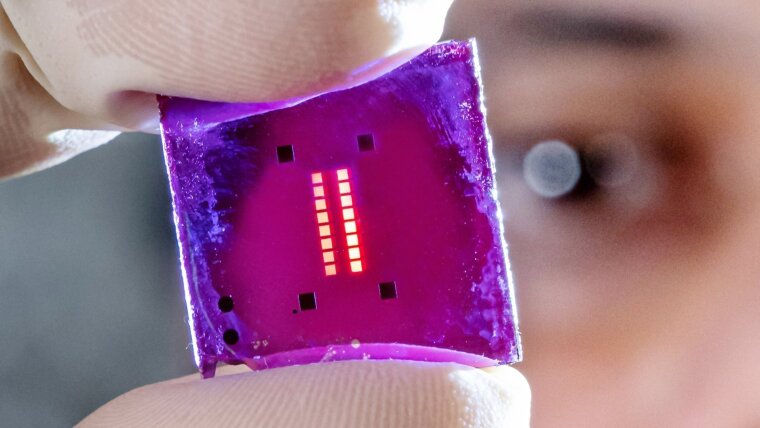
- Research
Published: | By: Marco Körner
Prof. Dr Felix H. Schacher, Dr Purushottam Poudel, Dr Sarah Walden & Prof. Dr Isabelle Staude (l.t.r.)
Image: Jens Meyer (University of Jena)A material coating, whose light refraction properties can be precisely switched between different states, has been developed by an interdisciplinary research team from the Chemistry and Physics departments at the University of Jena. The team, led by Felix Schacher, Sarah Walden, Purushottam Poudel, and Isabelle Staude, combined polymers that react to light with so-called meta-surfaces. This innovation has led to the creation of new optical components that could potentially be used in signal processing. Their findings have now been published in the journal “ACS Nano”.
Combining Two Established Systems to Create Something New
“Both meta-surfaces and light-switchable polymers have been known in principle for decades,” explains Sarah Walden from the Institute of Solid State Physics, who now leads a research group in Australia. She adds, “but we are the first to combine both in this form to develop new components for optical applications.” Meta-surfaces are nanostructured thin layers whose characteristic structural sizes are smaller than the wavelength of light. This allows the properties of light and its propagation to be specifically influenced, enabling a variety of optical functions that would otherwise be performed by lenses, polarizers, or gratings. On the other hand, switchable polymers are plastics whose properties – such as the light refraction index – can change between different states.
“The polymers we used contain dye molecules,” Felix Schacher from the Institute of Organic Chemistry and Macromolecular Chemistry continues. “This means that they absorb light of a certain wavelength and, in doing so, change their structure - and thus their properties, such as the refractive index of light in this case.” To switch the dye back to its previous structure with the corresponding property, light of a different wavelength is required. “What's special about our system,” explains physicist Isabelle Staude, “is that the changes in refractive index affect the optical properties of the meta-surface when it is coated with such a polymer.” The changes achieved were surprisingly significant, even compared to previously known similar systems. “Because the polymers show different absorption depending on the dye, various effects can be very well separated from one another or combined,” the physicist summarises.
Unusual Physical Behaviour
Besides this promising result, the team made a surprising discovery: “In our work, we used two different dyes separately, each applied to a meta-surface. This confirmed the effect,” Schacher elaborates. “However, when mixing both switchable polymers, additional effects occur,” he reports. “We suspect that the two different dye molecules interact with each other, but we cannot say for certain at this point.” Further investigations are needed to clarify this interesting behaviour.
Fundamental Research with an Eye on Optical Artificial Intelligence
Although the primary focus with these switchable surfaces was to demonstrate the basic principle, the research group can envision several applications: “Since these surfaces can switch between different property states with light, sensor technology is a natural application area.” It is also conceivable that such switchable surfaces could be used for optical data processing. “Of course, it would delight our team if these components could be used for optical neural networks, for example, which could then process image information in the same way that electronic artificial intelligence can now,” says Schacher. “However, because this type of data processing is based on light rather than electronics, it is significantly more energy-efficient and faster than traditional computer-based AI.”
Original publication:
Sarah L. Walden, Purushottam Poudel, Chengjun Zou, Katsuya Tanaka, Pallabi Paul, Adriana Szeghalmi, Thomas Siefke, Thomas Pertsch, Felix H. Schacher, Isabelle Staude: „Two-Color Spatially Resolved Tuning of Polymer-Coated Metasurfaces“, ACS Nano, 2024, DOI: 10.1021/acsnano.3c11760External link

